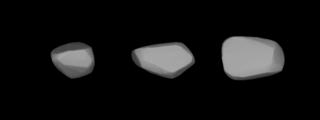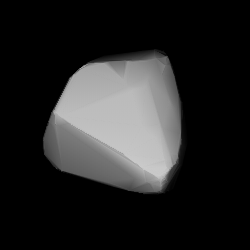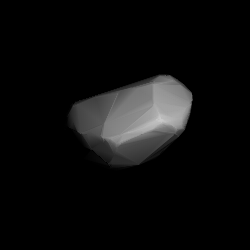Related Research Articles
Wolf Bickel is a German amateur astronomer and a prolific discoverer of asteroids, observing at his private Bergisch Gladbach Observatory, Germany. He is the most successful German discoverer of minor planets.
1019 Strackea, provisional designation 1924 QN, is a stony Hungaria asteroid of the inner asteroid belt, approximately 8 kilometers in diameter. It was discovered on 3 March 1924, by astronomer Karl Reinmuth at Heidelberg Observatory in southwest Germany. It is named for German astronomer Gustav Stracke.

9936 Al-Biruni, provisional designation 1986 PN4, is a carbonaceous asteroid from the outer region of the asteroid belt, approximately 24 kilometers in diameter. It was discovered on 8 August 1986, by Belgian and Bulgarian astronomers Eric Elst and Violeta Ivanova at the Rozhen Observatory, located in Bulgaria's Smolyan province near the border to Greece. It was named for Persian medieval scholar Al-Biruni.
4263 Abashiri, provisional designation 1989 RL2, is a stony Flora asteroid from the inner regions of the asteroid belt, approximately 8 kilometers in diameter.
3181 Ahnert, provisional designation 1964 EC, is a stony Flora asteroid from the inner regions of the asteroid belt, about 8 kilometers in diameter. It was discovered by German astronomer Freimut Börngen at the Karl Schwarzschild Observatory in Tautenburg, eastern Germany, on 8 March 1964.
3567 Alvema, provisional designation 1930 VD, is a dark asteroid from the middle region of the asteroid belt, approximately 14 kilometers in diameter. It was discovered by Belgian astronomer Eugène Delporte at the Royal Observatory of Belgium in Uccle, on 15 November 1930. It was named after the discoverer's three great-granddaughters Aline, Vérionique and Martine.
5171 Augustesen, provisional designation 1987 SQ3, is a background asteroid and slow rotator from the inner regions of the asteroid belt, approximately 8 kilometers (5 miles) in diameter. It was discovered on 25 September 1987, by Danish astronomer Poul Jensen at the Brorfelde Observatory in Denmark. The suspected tumbler and presumed Vestian asteroid has an exceptionally slow rotation period of 480 hours and possibly an elongated shape. It was named after Danish astronomer Karl Augustesen.
2637 Bobrovnikoff, provisional designation A919 SB, is a background asteroid from the inner regions of the asteroid belt, approximately 6 kilometers in diameter. It was discovered on 22 September 1919, by German astronomer Karl Reinmuth at the Heidelberg-Königstuhl State Observatory in Heidelberg, Germany. The presumed spherical S-type asteroid has a rotation period of 4.79 hours. It is named after astronomer Nicholas Bobrovnikoff, who was the director of the Perkins Observatory in Ohio, United States.
1543 Bourgeois, provisional designation 1941 SJ, is a stony asteroid from the central asteroid belt's background population, approximately 12 kilometers in diameter. It was discovered on 21 September 1941, by astronomer Eugène Delporte at the Royal Observatory of Belgium in Uccle. The asteroid was named after Belgian astronomer Paul Bourgeois.
1307 Cimmeria, provisional designation 1930 UF, is a stony asteroid from the inner regions of the asteroid belt, approximately 10 kilometers in diameter. It was discovered on 17 October 1930, by Soviet astronomer Grigory Neujmin at Simeiz Observatory on the Crimean peninsula, and later named after the Cimmerians, the ancient people of Crimea.
1309 Hyperborea is a carbonaceous background asteroid from the outermost regions of the asteroid belt, approximately 57 kilometers in diameter. It was discovered on 11 October 1931, by Soviet astronomer Grigory Neujmin at the Simeiz Observatory on the Crimean peninsula, and given the provisional designation 1931 TO. The asteroid was named after Hyperborea, the northern homeland of a Greek mythical race of giants.

1682 Karel, provisional designation 1949 PH, is a stony Florian asteroid from the inner regions of the asteroid belt, approximately 7.5 kilometers in diameter.
1817 Katanga, provisional designation 1939 MB, is a stony Phocaea asteroid in from the inner regions of the asteroid belt, approximately 16 kilometers in diameter. It was discovered on 20 June 1939, by English-born South African astronomer Cyril Jackson at Johannesburg Observatory in South Africa. It is named for the Katanga Province.

1361 Leuschneria, provisional designation 1935 QA, is a carbonaceous asteroid from the outer regions of the asteroid belt, approximately 30 kilometers in diameter. It was discovered on 30 August 1935, by Belgian astronomer Eugène Delporte at Uccle Observatory in Belgium, and named after American astronomer Armin Otto Leuschner.
1939 Loretta, provisional designation 1974 UC, is a carbonaceous Themistian asteroid from the outer region of the asteroid belt, approximately 30 kilometers in diameter. It was discovered on 17 October 1974, by American astronomer Charles Kowal at Palomar Observatory in California, who named it after his daughter, Loretta Kowal. The discovery of the asteroid took place during Kowal's follow-up observations of Jupiter's moon Leda, which he had discovered one month prior.

1431 Luanda, provisional designation 1937 OB, is a stony Eunomian asteroid from the central regions of the asteroid belt, approximately 14 kilometers in diameter. It was discovered on 29 July 1937, by South African astronomer Cyril Jackson at the Union Observatory in Johannesburg. The asteroid was named after the city of Luanda.
1739 Meyermann, provisional designation 1939 PF, is a stony Florian asteroid from the inner regions of the asteroid belt, approximately 7.5 kilometers in diameter. It was discovered by German astronomer Karl Reinmuth at Heidelberg Observatory on 15 August 1939. It was later named in memory of astronomer Bruno Meyermann.
14968 Kubáček, provisional designation 1997 QG, is a stony background asteroid from the middle region of the asteroid belt, approximately 5 kilometers in diameter. The asteroid was discovered on 23 August 1997, by Slovak astronomers Adrián Galád and Alexander Pravda at Modra Observatory, Slovakia. It was named for Slovak astronomer Dalibor Kubáček.
6181 Bobweber, provisional designation 1986 RW, is a stony asteroid from the inner regions of the asteroid belt, approximately 5 kilometers in diameter. It was discovered on 6 September 1986, by American astronomer Eleanor Helin at the U.S. Palomar Observatory in California, and named after astronomer Robert Weber.
12564 Ikeller, provisional designation 1998 SO49, is a stony Koronian asteroid from the outer region of the asteroid belt, approximately 5 kilometers in diameter.
References
- 1 2 3 4 "JPL Small-Body Database Browser: 4324 Bickel (1981 YA1)" (2017-06-02 last obs.). Jet Propulsion Laboratory . Retrieved 20 June 2017.
- 1 2 3 4 5 "4324 Bickel (1981 YA1)". Minor Planet Center. Retrieved 5 April 2016.
- 1 2 3 4 Masiero, Joseph R.; Mainzer, A. K.; Grav, T.; Bauer, J. M.; Cutri, R. M.; Nugent, C.; et al. (November 2012). "Preliminary Analysis of WISE/NEOWISE 3-Band Cryogenic and Post-cryogenic Observations of Main Belt Asteroids". The Astrophysical Journal Letters. 759 (1): 5. arXiv: 1209.5794 . Bibcode:2012ApJ...759L...8M. doi:10.1088/2041-8205/759/1/L8 . Retrieved 17 May 2016.
- 1 2 3 4 5 6 "LCDB Data for (4324) Bickel". Asteroid Lightcurve Database (LCDB). Retrieved 17 May 2016.
- 1 2 3 Behrend, Raoul. "Asteroids and comets rotation curves – (4324) Bickel". Geneva Observatory . Retrieved 17 May 2016.
- 1 2 Ivanova, V. G.; Apostolovska, G.; Borisov, G. B.; Bilkina, B. I. (November 2002). "Results from photometric studies of asteroids at Rozhen National Observatory, Bulgaria". In: Proceedings of Asteroids: 505–508. Bibcode:2002ESASP.500..505I . Retrieved 17 May 2016.
- ↑ Veres, Peter; Jedicke, Robert; Fitzsimmons, Alan; Denneau, Larry; Granvik, Mikael; Bolin, Bryce; et al. (November 2015). "Absolute magnitudes and slope parameters for 250,000 asteroids observed by Pan-STARRS PS1 - Preliminary results". Icarus. 261: 34–47. arXiv: 1506.00762 . Bibcode:2015Icar..261...34V. doi:10.1016/j.icarus.2015.08.007 . Retrieved 17 May 2016.
- ↑ "MPC/MPO/MPS Archive". Minor Planet Center. Retrieved 17 May 2016.
- ↑ "Bickel überholt Börngen – die erfolgreichsten deutschen Kleinplanetenentdecker" [Bickel overtakes Börgen – Most prolific German discoverers of minor planets](PDF). VdS-Journal – Vereinigung der Sternfreunde. April 2013. pp. 80–83. Retrieved 5 April 2016.
- ↑ "Minor Planet Discoverers (by number)". Minor Planet Center. 23 March 2016. Retrieved 5 April 2016.